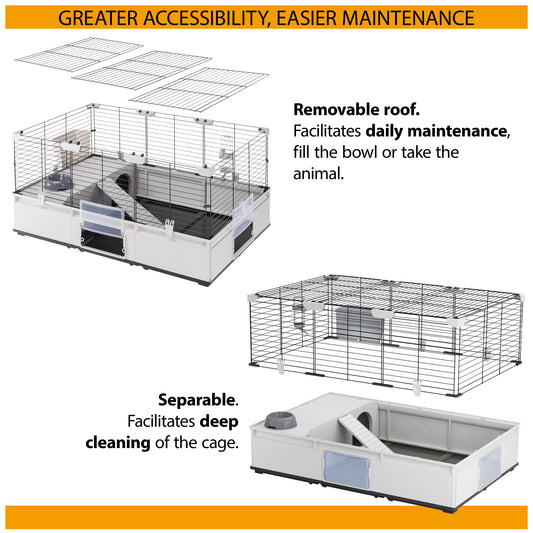Moving house is stressful for humans but a change of living environment can be particularly traumatic for cats as they are territorial animals that form strong attachments to their homes. Your cat will have likely spent a lot of time scent-marking your current home and won’t be keen to leave. However, with a bit of prior planning, your new house will soon be home sweet home for both of you.
Before the move
If your cat is used to staying in a cattery when you go on holiday it might be a good idea to book them in for a couple of days while you move. This way you won’t need to worry about them getting stressed by all the coming and going, or getting under your feet as you’re carrying boxes.
If you are not using a cattery, nominate one room in the house to keep your cat during the move. Get your cat used to being kept in this room a few days before moving day by making it a cosy place to be. Make sure they have everything they need in there – such as food, water, litter tray, toys and bedding – and put a sign on the door reminding everyone that the cat is in there and to keep the door closed.
You should also leave your cat’s carrier in there with its door open so your pet can become familiar with it before moving day. To make the carrier more appealing, you could put in an item of your clothing or a blanket with your scent on to make them feel more at home.
Moving day
When travelling to your new home, ensure your cat is safely stored in an appropriate cat carrier and that it is secured in the car with a seatbelt. If your cat gets stressed while travelling, before they get in you could spray the inside of the carrier with a calming cat spray.
When you arrive at your new house, you should choose one room for your cat to stay in for the first few days. Ideally this should be a spare bedroom or another room that isn’t too busy. Your cat will feel safer within a confined space as long as they have everything they need in there with them.
Put your pet’s bowls, litter tray, bedding, scratching post, toys and some cardboard boxes in with them and keep the door shut. Again, put a sign on the door to remind people! When you bring your cat in, put the carrier on the floor in this room and leave the door open for them to come out when they are ready.
Try to keep to your cat’s usual routine as much as possible, including the amount of time that you usually spend playing with them.
After the move
When you are all unpacked and your cat seems comfortable in their new room, you can open the door and let them explore the rest of the house.
Before you let your cat out make sure the whole house is escape-proof. Check windows and doors, and watch out for any cat flaps or chimneys. Cats can make a dash for freedom out of the smallest of spaces and in a new neighbourhood they could easily become lost.
Place multiple litter trays, bowls, scratching posts and bedding around the house so your cat has plenty of resources in a choice of locations – this will help them feel at home. Scratching posts in particular will encourage your cat to deposit familiar scents from the glands in their paws to help them settle.
You can give your cat a head start spreading their scent by doing it for them. Gently wipe a cloth around the lower part of your cat’s face to pick up their ‘personal scent profile’ and rub it on surfaces at your cat’s height.
Don’t force your cat to explore the house. If they have decided to hide under the bed for a couple of days that’s fine. They will come out when they are ready and confident that it is safe to do so. You can tell when your cat is feeling secure in their new home as you will notice they start scent-marking by rubbing their face against surfaces.
If your cat is used to being outdoors you can make their time indoors more exciting by providing plenty of things for them to do. Toys like puzzle feeders will keep them mentally stimulated and you’re sure to have plenty of empty cardboard boxes around for them to play with!
Going outside
Allowing your cat to go outside for the first time can be a little nerve-racking. It is generally a good idea to wait at least three weeks before letting them out so that they have had a chance to mark their new territory. Let them out just before a meal time so they are unlikely to stray far before coming back to eat. Shaking their dry food can be a good way of recalling a hungry cat.
Consider sprinkling some of your cat’s used litter around the edge of your garden before you let them out for the first time. This will mean that your garden already smells familiar and it will warn other cats in the area that there is a new cat on the block.
It is not uncommon for a cat to disappear from a new house and turn up back at their old pad, especially if they’ve not moved very far. Cats can easily pick up the scent of a previous territory nearby and find their way back. If you think this could happen, warn the new occupants so they can contact you if your cat shows up. Advise them not to feed your cat or you’ll be unlikely to be able to get them back! If this wandering persists, keep your cat in for a few more weeks to make sure they have thoroughly marked their new territory.
Don’t forget!
In all the admin that comes with moving house, don’t forget there are some very important changes that need to be made regarding your pet. If you are moving to a new area you will need to register with a vet as soon as possible and inform your pet insurance provider of your change of address. Most importantly, remember to change the contact details relating to your pet’s microchip and get them a new ID tag for their collar. Sadly, many of the cats that go missing can never be reunited with their owners due to out-of-date contact details held by microchip databases.
Shop All Cat
If you enjoyed this article, have a look at:









